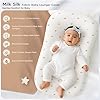Cpzzkq Baby Lounger Cover 2 Pack - Silky Soft and Breathable Infant Lounger Cover, Newborn Lounger Slipcover for Baby Boys Girls, Fits Cpzzkq & Most Loungers, Cover Only, Brown
13% Offdearlomum Baby Play Mat Gym, Funny Play Piano Tummy Time Activity Mat with 5 Infant Sensory Toys, Music and Lights, Boy & Girl Gifts for Newborns 0 to 3 6 9 12 Months (Pink)
9% OffIntroduction
Your baby is two months old, and you are beginning to notice some exciting developments. At this age, the baby is starting to play around with things and is becoming more interactive with the people around. There is a bond that is starting to develop between you and your baby because the baby can easily recognize you
As a new parent, this is the stage that you need to give your baby all the attention that he will need. By understanding your 2-month-old baby’s feeding schedule, developmental milestones, and nutritional requirements, you can give enough comfort and happiness to the baby. In this article, we are going to look at all the developmental milestones and understanding the basics of a two-month-old baby, concerns, feeding schedules, and baby care basics that you need to know.
Baby Developmental Milestones
As the baby enters the second month, there are body changes you can easily see. Such changes include body weight, body movements, and personality. Let’s delve a bit deeper into the developmental stages of a 2-month-old baby.
Body Changes
The body changes here include every growth and development that you can see in your baby. Such body developments include;
Gaining More Weight
Generally, the average weight of a 2-month-old female baby is about 10.5 – 11.3 pounds while that of a male baby is between 11.5 – 12.3 pounds. However, the weights may vary due to variations in the nutritional supplies. You will notice that the baby’s entire body grows steadily with the legs and hands becoming chubbier than in the first month.
Body Movements
It is in the second month that the baby begins to develop muscles that will facilitate body movements. During the second month, the child gets stronger every day and starts to make slight movements including both the legs and arms. The newborn’s first reflexes begin to fade as new movements appear.
Closure of the Posterior Fontanel
The posterior fontanel is a gap present between bones in the baby’s skull. It appears as a soft spot on the head of your baby. In most cases, the gap closes when babies are two months old. However, some may take up to three months.
Read Related Article On hacks for traveling with babies
Brain Development

Baby Teething Toy
- Baby’s brain development becomes evident as their senses start to prevail.
- Baby starts moving their eyes from one end to another.
- At this age, the baby should be smiling, laughing, or squealing.
- At two months old, the baby’s ability to recognize faces begins to develop.
- Most babies can easily identify people who spend a lot of time with them.
- These people may include family members, close relatives, or the babysitter
Don’t be surprised when the baby begins to make strange noises or sounds. When that happens, know that your baby is learning to talk. When “conversing” with them, the babies respond in a way showing that they are “listening.” Such responses include cooing, touching your face, or gurgling.
When to Consult a Pediatrician
As you monitor your baby’s developmental stages, remember that the milestones may vary with each baby. But you don’t have to assume instances when your baby is not showing some of these developments. You should be concerned when your baby is not;
- Gaining more weight or feeding well
- Showing signs of facial recognition
- Moving the arms, legs, or even the whole body
- Lifting the head when you hold the baby on your chest
- Moving the head sideways in response to your hand movements
2-Month-Old Baby Feeding Schedule

Nursing Pads
- Baby at this age has a small tummy and can eat small amounts of food frequently.
- Whether formula feeding or breastfeeding, it’s important to ensure the baby gets enough food.
- This can be achieved by using a feeding schedule or observing signs that indicate the baby is satisfied.
But how do you know when your baby is hungry? Whenever you notice the baby licking the lips, sucking the fingers or hands, and opening the mouth frequently, consider feeding the baby. Don’t wait until the baby begins crying. Now, let’s take a look at the frequency and the amount of milk or formula that you should feed your baby when hungry.
Breastfeeding
A two-month-old baby usually eats between 6 – 8 times per day with 3 – 4 ounces per feeding. Most likely, your baby will get hungry after every two to three hours. In fact, most babies will naturally stop feeding once their stomach is full.
As a breastfeeding parent, you need to eat foods that will increase your milk production. By doing so, you will make sure that your baby gets enough breast milk all day. An inadequate supply of milk may deprive your baby of getting enough milk, which may eventually result in retarded growth.
Formula Feeding
The formula takes a longer time to digest. Therefore, you ought to feed your baby after every 3 to 4 hours. The baby’s stomach can hold between 4 to 5 ounces of formula per feeding. You can feed the baby between 6 to 7 times per day.
For healthy feeding, remember to clean the bottles and cans used for formula feeding. You can also check on the expiry date of the formula before feeding the baby. If expired, you should dispose of the formula can. Remember to clean the baby feeding bottles and nipples before feeding your baby. Consider replacing them if broken or over-used.
The General Basics of Baby Care
At two months of age, the baby needs a lot of care and attention. To avoid complications of health that may arise, you need to understand and implement all the baby care basics and tips. Here are some of the tips that will help you maintain a healthy living in your baby.
- Change the baby’s diapers immediately it becomes wet to prevent diaper rashes
- To avoid sneezing, keep the baby away from sprays or dust because the baby is highly sensitive to such irritants
- Consult your pediatrician whenever you notice some white patches (thrush) on the baby’s tongue
- If you are breastfeeding, you should consider supplementing your baby’s milk with Vitamin D
- Ensure that your baby is vaccinated against rotaviruses and polioviruses
- Understand the sleeping pattern of your baby to help you determine the feeding time
Conclusion:
As a new parent, understanding the basics of a two-month-old baby’s development is crucial in ensuring their healthy growth. By knowing the baby’s feeding habits, sleeping patterns, and developmental milestones, you can provide the best care for your little one. Remember to always consult with your pediatrician if you have any concerns. With patience, love, and care, you’ll navigate through this new and exciting journey of parenthood.
Related Links:
- https://en.wikipedia.org/wiki/Infant /By Wikipedia
- https://en.wikipedia.org/wiki/Child_development_stages /By Wikipedia
- https://www.wikihow.com/Take-Care-of-a-Newborn /By Wikihow
- https://www.wikihow.com/Care-for-a-Baby /By Wikihow
- https://www.wikihow.com/Handle-a-Newborn-Baby /By Wikihow
- https://www.wikihow.com/Lift-and-Carry-a-Baby /By Wikihow
- https://www.wikihow.mom/Hold-a-Baby /By Wikihow

Hi there!
My name is Sabrina. As a devoted mother of four children, I have personally experienced the benefits and effectiveness of various types of baby swings. As the founder of babyswingclub.com, I have dedicated myself to providing valuable information and insights into the world of baby swings.
My thorough research and hands-on experience allow me to offer valuable insights into the features, safety standards, and overall performance of different baby swings.

























